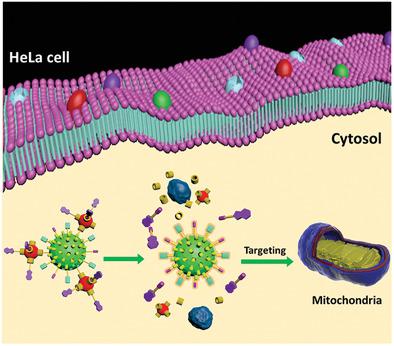当前位置:
X-MOL 学术
›
Part. Part. Syst. Charact.
›
论文详情
Our official English website, www.x-mol.net, welcomes your
feedback! (Note: you will need to create a separate account there.)
Coassembled Nanoparticles Composed of Functionalized Mesoporous Silica and Pillar[5]arene‐Appended Gold Nanoparticles as Mitochondrial‐Selective Dual‐Drug Carriers
Particle & Particle Systems Characterization ( IF 2.7 ) Pub Date : 2020-07-30 , DOI: 10.1002/ppsc.202000136 Junho Ahn 1 , Hanyong Jin 2 , Jaehyeon Park 3 , Boeun Lee 2 , Mirae Ok 3 , Ji Ha Lee 4 , Jeehyeon Bae 2 , Jong Hwa Jung 3
Particle & Particle Systems Characterization ( IF 2.7 ) Pub Date : 2020-07-30 , DOI: 10.1002/ppsc.202000136 Junho Ahn 1 , Hanyong Jin 2 , Jaehyeon Park 3 , Boeun Lee 2 , Mirae Ok 3 , Ji Ha Lee 4 , Jeehyeon Bae 2 , Jong Hwa Jung 3
Affiliation

|
Coassembled nanoparticles composed of functionalized mesoporous silica and pillar[5]arene‐appended Au nanoparticles obtained through the formation of a host–guest complex are designed and synthesized as a mitochondrial‐selective dual‐drug delivery system. A pyridinium‐based ligand and fluorescein isothiocyanate are immobilized onto mesoporous silica to act as the mitochondria‐targeting ligand and fluorescence tracker, respectively, of a material dubbed NP‐3. Carboxylated pillar[5]arene‐capped Au nanoparticles (CP‐AuNPs) are fabricated by the templated reduction of Au3+. Interestingly, coassembled nanoparticles (NP‐1) composed of doxorubicin (DOX) loaded NP‐3 and CP‐AuNPs are then prepared via the formation of a host–guest complex between the pyridinium‐based ligand of NP‐3 and the pillar[5]arene of CP‐AuNPs. To demonstrate the effectiveness of NP‐2 and NP‐1 as mitochondrial targeting drug delivery systems, DOX and F16 are employed as model drugs. These drugs loaded onto NP‐2 and CP‐AuNPs, respectively, are selectively delivered to mitochondria, indicating the usefulness of NP‐2 and CP‐AuNPs as mitochondrial‐specific drug‐delivery carriers in cancer cells. More interestingly, the use of NP‐1 is also associated with the selective accumulation of DOX and F16 in mitochondria. The selective mitochondrial‐targeting of NP‐1 is possible by NP‐2 and F16 exposed to the cytoplasm, allowing the codelivery of the two drugs to the mitochondria.
中文翻译:

由功能化介孔二氧化硅和支柱[5]芳烃附加的金纳米粒子组成的共组装纳米粒子,作为线粒体选择性双药物载体
通过功能化介孔二氧化硅和形成柱-客体复合物而获得的附有支柱[5]芳烃的金纳米粒子组成的共组装纳米粒子,被设计并合成为线粒体选择性双重药物递送系统。基于吡啶鎓的配体和异硫氰酸荧光素被固定在中孔二氧化硅上,分别充当被称为NP-3的材料的线粒体靶向配体和荧光跟踪剂。通过模板化还原Au 3+可以制备羧基化的柱[5]芳烃封端的Au纳米颗粒(CP-AuNPs)。有趣的是,由阿霉素(DOX)负载的NP-3和CP-AuNPs组成的共组装纳米颗粒(NP-1)然后通过在NP-3吡啶基配体与柱子之间形成主体-客体复合物来制备[5]。 CP-AuNP的] arene。为了证明NP-2和NP-1作为线粒体靶向药物递送系统的有效性,将DOX和F16用作模型药物。这些分别装载在NP-2和CP-AuNPs上的药物被选择性地递送至线粒体,表明NP-2和CP-AuNPs作为癌细胞中线粒体特异性药物递送载体的有用性。更有趣的是,NP-1的使用还与线粒体中DOX和F16的选择性积累有关。NP-2和F16暴露于细胞质可以实现NP-1的选择性线粒体靶向,
更新日期:2020-09-16
中文翻译:

由功能化介孔二氧化硅和支柱[5]芳烃附加的金纳米粒子组成的共组装纳米粒子,作为线粒体选择性双药物载体
通过功能化介孔二氧化硅和形成柱-客体复合物而获得的附有支柱[5]芳烃的金纳米粒子组成的共组装纳米粒子,被设计并合成为线粒体选择性双重药物递送系统。基于吡啶鎓的配体和异硫氰酸荧光素被固定在中孔二氧化硅上,分别充当被称为NP-3的材料的线粒体靶向配体和荧光跟踪剂。通过模板化还原Au 3+可以制备羧基化的柱[5]芳烃封端的Au纳米颗粒(CP-AuNPs)。有趣的是,由阿霉素(DOX)负载的NP-3和CP-AuNPs组成的共组装纳米颗粒(NP-1)然后通过在NP-3吡啶基配体与柱子之间形成主体-客体复合物来制备[5]。 CP-AuNP的] arene。为了证明NP-2和NP-1作为线粒体靶向药物递送系统的有效性,将DOX和F16用作模型药物。这些分别装载在NP-2和CP-AuNPs上的药物被选择性地递送至线粒体,表明NP-2和CP-AuNPs作为癌细胞中线粒体特异性药物递送载体的有用性。更有趣的是,NP-1的使用还与线粒体中DOX和F16的选择性积累有关。NP-2和F16暴露于细胞质可以实现NP-1的选择性线粒体靶向,











































 京公网安备 11010802027423号
京公网安备 11010802027423号